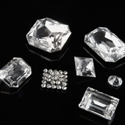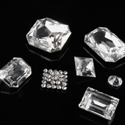Diamonds are a scientist’s best friend
Two papers appearing in Physical Review Letters take different routes toward investigating the legendary hardness of diamond. Diamond is used to investigate the high-pressure behavior of solids, through diamond-anvil cells. However, these cells can typically only withstand pressures of up to 300 due to the mechanical strength limit of diamond. While this may seem high enough, it is believed that the pressures exceed 1 at the core of planets like Jupiter and Saturn. The nature of solids at such pressures remains a mystery.
To study solids at higher pressures, a group of researchers at the Lawrence Livermore National Laboratory present a novel ramp-wave compression technique that allows them to study diamond at 800 . The diamond sample is ablated with x-ray lasers that are ramped up monotonically until a uniform compression wave is produced. This wave propagates faster than the thermal wave caused by the laser ablation, resulting in compression without heating.
In another study on diamond, researchers from Université Paris Nord, Université Blaise Pascal, and Université Pierre et Marie Curie have investigated the solubility of boron in diamond at the European Synchrotron Radiation Facility in Grenoble, France. They have synthesized cubic boron carbide ( ), a diamondlike phase with the highest boron content ever achieved. Compared to diamond, the Vickers hardness of is slightly less, but it has a comparable hardness at the nanoscale and nearly twice the fracture toughness. This makes an exceptional super-abrasive and a promising material for high-temperature electronics applications. – Daniel Ucko





